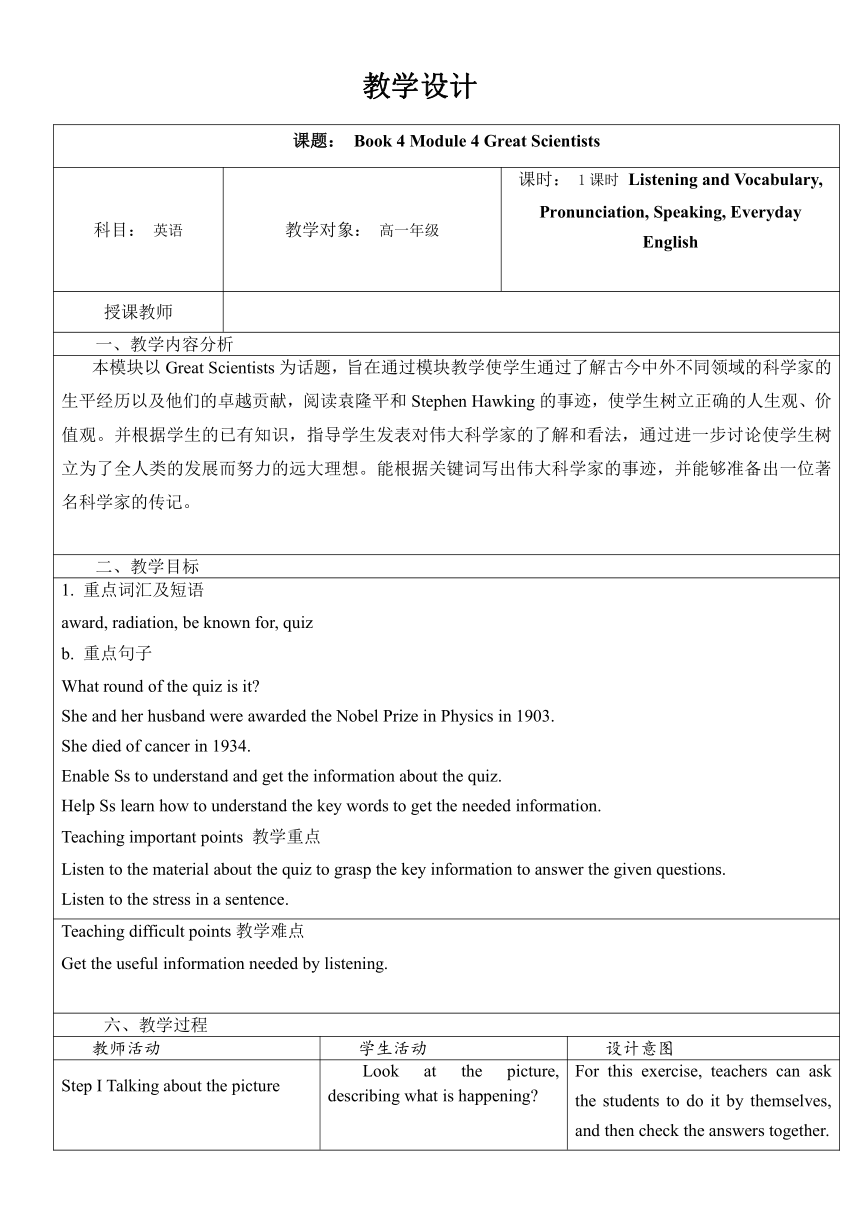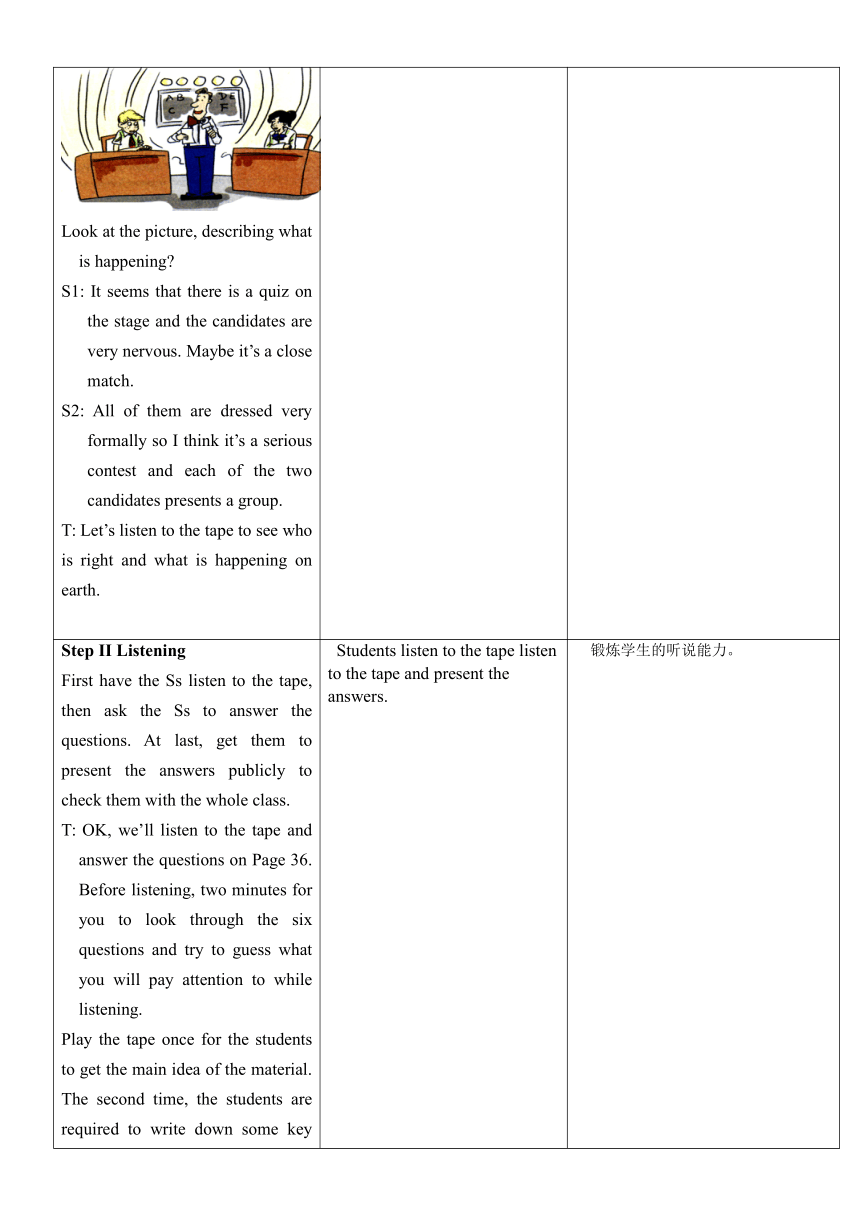外研版必修四 Module 4 Great Scientists-Listening and Vocabulary, Pronunciation 教学设计
文档属性
| 名称 | 外研版必修四 Module 4 Great Scientists-Listening and Vocabulary, Pronunciation 教学设计 |  | |
| 格式 | zip | ||
| 文件大小 | 2.1MB | ||
| 资源类型 | 教案 | ||
| 版本资源 | 外研版 | ||
| 科目 | 英语 | ||
| 更新时间 | 2022-09-25 20:54:10 | ||
图片预览


文档简介
教学设计
课题: Book 4 Module 4 Great Scientists
科目: 英语 教学对象: 高一年级 课时: 1课时 Listening and Vocabulary, Pronunciation, Speaking, Everyday English
授课教师
一、教学内容分析
本模块以Great Scientists为话题,旨在通过模块教学使学生通过了解古今中外不同领域的科学家的生平经历以及他们的卓越贡献,阅读袁隆平和Stephen Hawking的事迹,使学生树立正确的人生观、价值观。并根据学生的已有知识,指导学生发表对伟大科学家的了解和看法,通过进一步讨论使学生树立为了全人类的发展而努力的远大理想。能根据关键词写出伟大科学家的事迹,并能够准备出一位著名科学家的传记。
二、教学目标
1. 重点词汇及短语award, radiation, be known for, quizb. 重点句子What round of the quiz is it She and her husband were awarded the Nobel Prize in Physics in 1903.She died of cancer in 1934.Enable Ss to understand and get the information about the quiz.Help Ss learn how to understand the key words to get the needed information. Teaching important points 教学重点Listen to the material about the quiz to grasp the key information to answer the given questions.Listen to the stress in a sentence.
Teaching difficult points教学难点Get the useful information needed by listening.
六、教学过程
教师活动 学生活动 设计意图
Step I Talking about the pictureLook at the picture, describing what is happening S1: It seems that there is a quiz on the stage and the candidates are very nervous. Maybe it’s a close match. S2: All of them are dressed very formally so I think it’s a serious contest and each of the two candidates presents a group.T: Let’s listen to the tape to see who is right and what is happening on earth. Look at the picture, describing what is happening For this exercise, teachers can ask the students to do it by themselves, and then check the answers together.
Step II Listening First have the Ss listen to the tape, then ask the Ss to answer the questions. At last, get them to present the answers publicly to check them with the whole class.T: OK, we’ll listen to the tape and answer the questions on Page 36. Before listening, two minutes for you to look through the six questions and try to guess what you will pay attention to while listening. Play the tape once for the students to get the main idea of the material. The second time, the students are required to write down some key words of the answers, then ask some of them to present their answers. Play the tape for a third time to let them correct their answers and complete Part 3. Finally, ask the students to work in pairs, asking and answering the questions in Part 3 according to the listening material. If time permits, the teachers can play the tape for a fourth time for them to listen with their books closed, just for the detailed content. . Students listen to the tape listen to the tape and present the answers. 锻炼学生的听说能力。
Step III Word studyPart 4 can be used as a little competition to see who is good at mastering the meanings of the words. Dividing the class into two parts. Teachers can read the definition out and each group are encouraged to spell the word with the book closed. The winner will be praised. Students have a competition.. This step is to help students to speak English aloudly.
Step IV PronunciationStress is very important in pronouncing words. The same word with different stressmay have different meanings. We must pay attention to the stress of each word, especially stresses in long words.Read about stress in long words.Listen and underline the stresses. Students listen again and check the pronunciation with the whole class. This part is to prepare the students for the listening. Get them first to work in pairs and write down words and expressions for each profession, and then ask them to match the statements with the professions.
Step V SpeakingWork in pairs. Think of a famous scientist or inventor. Find the answers to these questions.When and where was he born Why was he famous Where did he live and work When did he discover / invent… scientistsInventions/ discoveriesscientistsInventions/ discoveriesIsaac NewtonDavid HoCharles DarwinMarie CurieSamuel C.C. TingAlexander FlemingCai LunSuggested answers:Isaac Newton→gravity Charles Darwin →theory of evolution Samuel C.C. Ting→the J-particle Cai Lun→paper David Ho→AIDS Marie Curie→X-rays Alexander Fleming →penicillin Students work in pairs and match the scientists with their inventions or discoveries first and then say what you know about them according to these questions. 考察学生的相关知识。
Step VI HomeworkDo the exercise on Page 38 to learn some everyday EnglishStep VII Exercise1. Finish exercises on page 89-90.2. Write a short passage about the famous scientist or inventor you’ve learned in Speaking (Page 38). Students try to finish homework. 引导学生自主完成作业和复习。
课题: Book 4 Module 4 Great Scientists
科目: 英语 教学对象: 高一年级 课时: 1课时 Listening and Vocabulary, Pronunciation, Speaking, Everyday English
授课教师
一、教学内容分析
本模块以Great Scientists为话题,旨在通过模块教学使学生通过了解古今中外不同领域的科学家的生平经历以及他们的卓越贡献,阅读袁隆平和Stephen Hawking的事迹,使学生树立正确的人生观、价值观。并根据学生的已有知识,指导学生发表对伟大科学家的了解和看法,通过进一步讨论使学生树立为了全人类的发展而努力的远大理想。能根据关键词写出伟大科学家的事迹,并能够准备出一位著名科学家的传记。
二、教学目标
1. 重点词汇及短语award, radiation, be known for, quizb. 重点句子What round of the quiz is it She and her husband were awarded the Nobel Prize in Physics in 1903.She died of cancer in 1934.Enable Ss to understand and get the information about the quiz.Help Ss learn how to understand the key words to get the needed information. Teaching important points 教学重点Listen to the material about the quiz to grasp the key information to answer the given questions.Listen to the stress in a sentence.
Teaching difficult points教学难点Get the useful information needed by listening.
六、教学过程
教师活动 学生活动 设计意图
Step I Talking about the pictureLook at the picture, describing what is happening S1: It seems that there is a quiz on the stage and the candidates are very nervous. Maybe it’s a close match. S2: All of them are dressed very formally so I think it’s a serious contest and each of the two candidates presents a group.T: Let’s listen to the tape to see who is right and what is happening on earth. Look at the picture, describing what is happening For this exercise, teachers can ask the students to do it by themselves, and then check the answers together.
Step II Listening First have the Ss listen to the tape, then ask the Ss to answer the questions. At last, get them to present the answers publicly to check them with the whole class.T: OK, we’ll listen to the tape and answer the questions on Page 36. Before listening, two minutes for you to look through the six questions and try to guess what you will pay attention to while listening. Play the tape once for the students to get the main idea of the material. The second time, the students are required to write down some key words of the answers, then ask some of them to present their answers. Play the tape for a third time to let them correct their answers and complete Part 3. Finally, ask the students to work in pairs, asking and answering the questions in Part 3 according to the listening material. If time permits, the teachers can play the tape for a fourth time for them to listen with their books closed, just for the detailed content. . Students listen to the tape listen to the tape and present the answers. 锻炼学生的听说能力。
Step III Word studyPart 4 can be used as a little competition to see who is good at mastering the meanings of the words. Dividing the class into two parts. Teachers can read the definition out and each group are encouraged to spell the word with the book closed. The winner will be praised. Students have a competition.. This step is to help students to speak English aloudly.
Step IV PronunciationStress is very important in pronouncing words. The same word with different stressmay have different meanings. We must pay attention to the stress of each word, especially stresses in long words.Read about stress in long words.Listen and underline the stresses. Students listen again and check the pronunciation with the whole class. This part is to prepare the students for the listening. Get them first to work in pairs and write down words and expressions for each profession, and then ask them to match the statements with the professions.
Step V SpeakingWork in pairs. Think of a famous scientist or inventor. Find the answers to these questions.When and where was he born Why was he famous Where did he live and work When did he discover / invent… scientistsInventions/ discoveriesscientistsInventions/ discoveriesIsaac NewtonDavid HoCharles DarwinMarie CurieSamuel C.C. TingAlexander FlemingCai LunSuggested answers:Isaac Newton→gravity Charles Darwin →theory of evolution Samuel C.C. Ting→the J-particle Cai Lun→paper David Ho→AIDS Marie Curie→X-rays Alexander Fleming →penicillin Students work in pairs and match the scientists with their inventions or discoveries first and then say what you know about them according to these questions. 考察学生的相关知识。
Step VI HomeworkDo the exercise on Page 38 to learn some everyday EnglishStep VII Exercise1. Finish exercises on page 89-90.2. Write a short passage about the famous scientist or inventor you’ve learned in Speaking (Page 38). Students try to finish homework. 引导学生自主完成作业和复习。
